Ghana Biodiversity and the Built Environment
Did you know that Ghana’s discovery of oil and gas in 2007 has raised concerns about the impact on biodiversity and the environment? The lack of scientific data and regulation has contributed to the ecological consequences of oil and gas production. But Ghana is not alone in facing these challenges. Countries like Nigeria, Congo, and Mozambique have also been affected.
Key Takeaways:
- Ghana’s oil and gas industry poses risks to biodiversity and the environment.
- Lack of scientific data and regulation exacerbates the ecological consequences.
- Other African countries, including Nigeria, Congo, and Mozambique, face similar challenges.
- Proper regulation and science education are essential for mitigating the negative effects.
- A balanced approach to economic development and environmental preservation is necessary for managing Ghana’s ecosystem.
Integrating Biodiversity into Urban Planning
Urban planning plays a crucial role in integrating biodiversity into the built environment in Ghana. It involves incorporating green spaces, such as parks and gardens, into urban areas to support biodiversity. Green infrastructure, such as green roofs and walls, can also enhance urban biodiversity. By incorporating these elements, urban planning can create habitats for plants and animals, improve air quality, and promote overall environmental sustainability. Additionally, urban biodiversity management strategies can help protect and enhance biodiversity within cities.
Importance of Green Spaces in Urban Areas
By integrating green spaces into urban areas, cities can create a harmonious balance between the built environment and nature. These green spaces provide essential habitats for plants and animals, supporting their survival and contributing to the overall biodiversity of the city. Additionally, green spaces offer numerous benefits to the residents, such as:
- Improved mental and physical well-being
- Enhanced air and water quality
- Noise reduction and mitigation
- Reduced heat island effect
Furthermore, green spaces encourage community engagement and connection with nature, fostering a sense of stewardship towards the environment.
Role of Green Infrastructure
Green infrastructure refers to the incorporation of natural elements, such as green roofs, vertical gardens, and permeable pavements, into the built environment. These features mimic natural ecosystems and provide a range of benefits, including:
- Enhanced stormwater management by reducing runoff and improving water quality
- Temperature regulation through evapotranspiration and shading
- Reduced energy consumption by improving building insulation
- Creation of additional habitat for plants and animals
The integration of green infrastructure in urban planning supports both biodiversity conservation and sustainable development.
| Biodiversity Conservation in Urban Planning | Sustainable Development |
|---|---|
| Preserves and protects native plant and animal species | Reduces ecological footprint and resource consumption |
| Creates wildlife corridors and connectivity | Promotes social and economic well-being |
| Improves air and water quality | Enhances the livability of cities |
Urban Biodiversity Management Strategies
To effectively manage and enhance urban biodiversity, cities must implement comprehensive strategies that address the unique challenges and opportunities of urban environments. These strategies may include:
- Creating protected areas within cities to preserve key habitats and species
- Implementing sustainable landscaping practices that support native plant and animal species
- Engaging communities in biodiversity monitoring and conservation efforts
- Collaborating with stakeholders to develop and implement urban biodiversity action plans
By adopting these strategies, cities can ensure the long-term conservation and sustainability of urban biodiversity.
Integrating biodiversity into urban planning is essential for building sustainable, resilient, and livable cities in Ghana. Ghana can serve as a model for other countries by demonstrating how biodiversity conservation can coexist with urban development. By prioritizing green spaces, green infrastructure, and urban biodiversity management, Ghana can create a future where nature thrives alongside vibrant urban areas.
Sustainable Architecture for a Greener Future
Sustainable architecture in Ghana plays a crucial role in promoting environmental sustainability and biodiversity conservation. By designing buildings that minimize their ecological impact, Ghana aims to create a greener future that harmonizes human needs with ecological preservation.
In sustainable architecture, eco-friendly construction materials are used to reduce the carbon footprint of buildings. These materials, such as recycled or locally sourced materials, not only minimize environmental damage but also contribute to the local economy.
Furthermore, sustainable architecture prioritizes energy-efficient systems to reduce the consumption of non-renewable resources. Integrated energy-saving technologies, such as solar panels and rainwater harvesting systems, help optimize energy usage and minimize waste. This approach not only lowers utility costs but also promotes environmental sustainability in the long run.
Another key aspect of sustainable architecture is the optimization of natural lighting and ventilation. By strategically designing buildings to maximize daylight and airflow, artificial lighting and mechanical cooling requirements can be minimized. This not only reduces energy consumption but also creates healthier and more comfortable living and working environments for occupants.
Ecological Design for Biodiversity Conservation
Incorporating ecological design principles into the architectural process is fundamental to promoting biodiversity conservation in Ghana. By carefully considering the natural surroundings and local ecosystems, architects and designers can create buildings that coexist harmoniously with nature.
Ecological design emphasizes the integration of green spaces within and around buildings to support biodiversity. This includes the incorporation of green roofs, vertical gardens, and landscaped areas. By providing habitat for plants and animals, these green spaces enhance biodiversity within urban areas and create a more sustainable and vibrant environment.
“Sustainable architecture not only minimizes environmental impact but also promotes a future where humanity and nature can thrive together.”
The Role of Sustainable Architecture in Environmental Sustainability
Sustainable architecture in Ghana is a key driver of environmental sustainability. By embracing sustainable design practices, Ghana can mitigate the negative environmental consequences often associated with traditional construction methods.
One of the main benefits of sustainable architecture is the reduction of greenhouse gas emissions. Energy-efficient buildings consume less power, resulting in lower carbon emissions. Additionally, sustainable architecture promotes the use of renewable energy sources, such as solar power, which further reduces reliance on fossil fuels.
The integration of sustainable architecture practices also contributes to water conservation efforts. Rainwater harvesting systems and efficient water fixtures minimize water wastage, reducing the strain on local water resources.
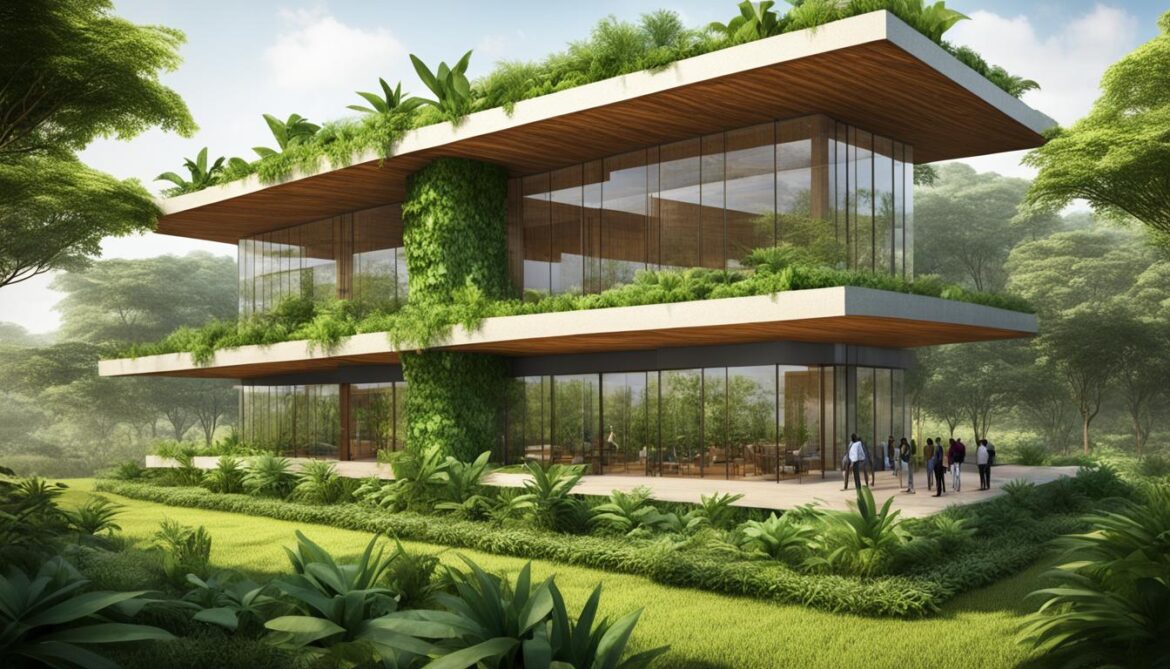
Moreover, sustainable architecture enhances the overall quality of life for inhabitants. The use of natural materials and optimized indoor environmental conditions promote health and well-being, creating spaces that inspire productivity and improve overall comfort.
By prioritizing sustainable architecture and design, Ghana is actively working towards creating a built environment that not only promotes environmental sustainability but also supports biodiversity conservation. Through innovative design solutions and a commitment to green practices, Ghana paves the way for a greener future that benefits both humans and the natural world.
The Importance of Biodiversity in the Built Environment
Biodiversity conservation Ghana is critical for the long-term sustainability and environmental sustainability Ghana of the built environment. Biodiversity provides essential ecosystem services that contribute to the well-being of urban areas. For instance, urban biodiversity management Ghana facilitates the pollination of plants, ensuring the production of food and maintenance of green spaces in cities. It also plays a vital role in water purification, enhancing the quality and availability of clean water for urban dwellers.
Climate regulation is another crucial function of biodiversity in the built environment. Natural habitats, such as forests and wetlands, help regulate temperature and mitigate the impacts of climate change by absorbing carbon dioxide. By preserving and incorporating biodiversity into urban planning and sustainable architecture, Ghana can mitigate the effects of climate change.
“Biodiversity is the key to maintaining ecological balance and ensuring the sustainability of urban ecosystems.”
By valuing and protecting biodiversity, Ghana can create a healthier and more sustainable environment for its citizens. It supports the ecological balance within cities, enhancing the resilience of local ecosystems to external pressures. The presence of diverse plant and animal species fosters a greater connection to nature and promotes mental and physical well-being among residents. Additionally, urban biodiversity management Ghana provides opportunities for recreation, education, and research, contributing to the overall quality of life in urban areas.
The Benefits of Incorporating Biodiversity in the Built Environment:
- Improved pollination and the production of food
- Enhanced water purification and quality
- Climate regulation and mitigation of climate change impacts
- Improved mental and physical well-being for residents
- Recreation, educational, and research opportunities
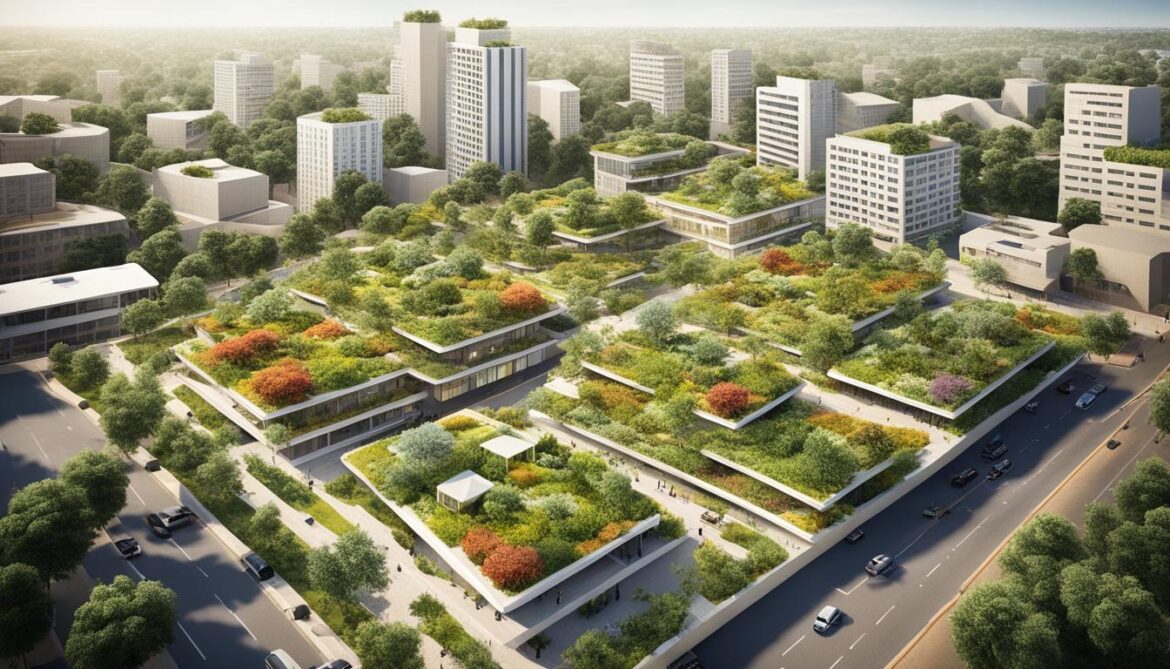
The table below highlights some examples of urban biodiversity management practices:
| Urban Biodiversity Management Strategies | Description |
|---|---|
| Green Roofs | Roof surfaces covered with vegetation, providing habitats for plants and insects, improving air quality, and reducing heat island effect. |
| Urban Gardens | Small-scale gardens within urban areas that support the growth of native plant species, attract pollinators, and provide access to fresh produce for residents. |
| Protected Natural Areas | Preservation of natural areas within cities, such as parks, wetlands, and forests, to maintain biodiversity and provide recreational spaces for residents. |
By embracing these strategies, Ghana can enhance the biodiversity of its built environment and ensure a sustainable future for generations to come.
The Annual Ghana Green Building Summit
The Annual Ghana Green Building Summit is a significant event that focuses on finding local solutions for sustainable architectural design, finance, and policy in Ghana. With a goal to reduce the negative impact of real estate projects on the environment, the summit aims to promote energy-saving measures and water conservation in the construction industry.
Bringing together a diverse group of professionals including architects, engineers, policymakers, and developers, the summit serves as a platform for knowledge and idea exchange. Participants engage in discussions and workshops dedicated to sustainable construction practices, exploring innovative approaches to create a greener built environment in Ghana.
The Annual Ghana Green Building Summit plays a crucial role in evaluating the country’s green building needs. By addressing the challenges and opportunities in sustainable architecture, the summit provides valuable insights and guidance for the adoption of eco-conscious construction techniques. Through collaborative efforts and shared expertise, the summit aims to transform Ghana’s construction industry towards a more sustainable future.
During the summit, participants explore strategies to integrate sustainable architecture into the Ghanaian context, considering the unique environmental and social factors. They discuss ways to incorporate green infrastructure, such as green roofs and walls, into building designs to enhance the ecological value of urban areas. Additionally, the summit addresses the financial aspect of green building projects, identifying viable financing options and exploring partnerships with stakeholders in the construction industry.
With an emphasis on fostering collaboration and knowledge-sharing, the Annual Ghana Green Building Summit is a testament to Ghana’s commitment to achieving a sustainable built environment. By harnessing the expertise and collective efforts of industry professionals, Ghana can pave the way for sustainable architecture, while promoting biodiversity conservation and green infrastructure development.
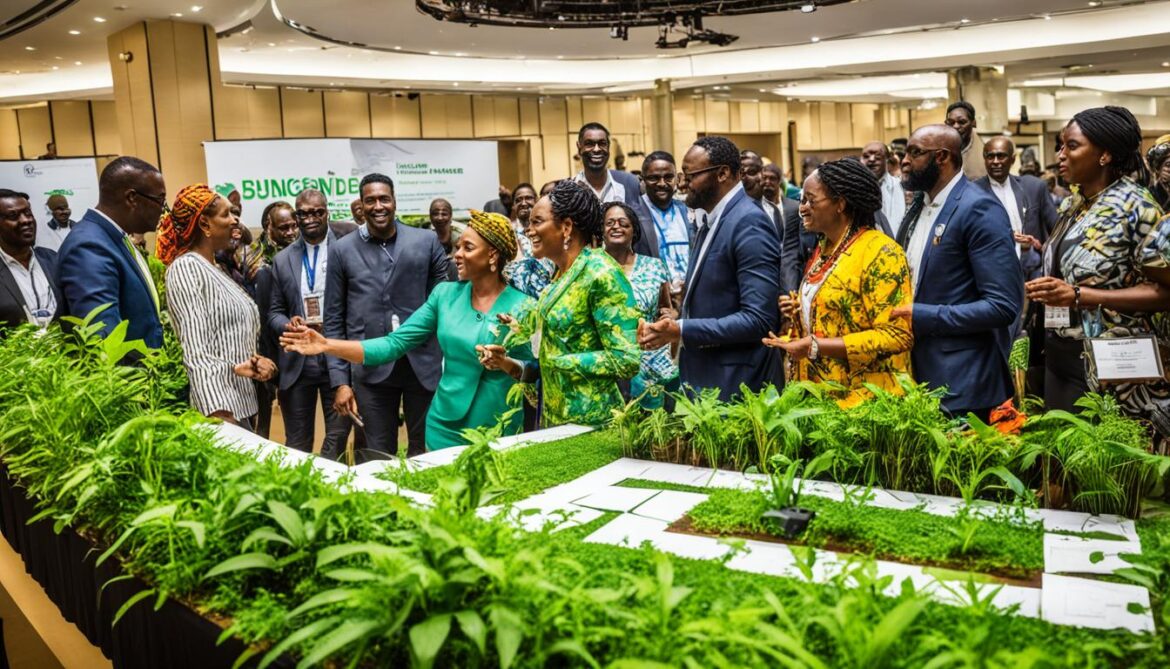
The Importance of Green Building Design in Ghana
Green building design in Ghana promotes eco-conscious construction techniques and sustainable building practices. It focuses on minimizing the environmental footprint of buildings, maximizing energy efficiency, and conserving resources. By incorporating sustainable design principles, such as using locally sourced materials and implementing energy-efficient systems, green buildings in Ghana can reduce energy consumption, greenhouse gas emissions, and waste generation. They also offer healthier and more comfortable living and working environments for occupants.
One of the key aspects of green building design is the use of locally sourced materials. By utilizing materials that are readily available within the region, the environmental impact of transportation and importation is reduced. This also helps to support local economies and promote sustainable practices in the construction industry.
“Green building design in Ghana is not just about minimizing environmental impact; it also focuses on creating spaces that prioritize the well-being and comfort of occupants. The use of natural lighting, ventilation, and thermal insulation ensures that buildings are not only energy-efficient but also provide a pleasant indoor environment,” says Kwame Asante, an architect specializing in sustainable design.
Energy efficiency is another crucial element of green building design. By incorporating energy-saving technologies such as solar panels, efficient lighting systems, and insulation, buildings can significantly reduce their energy consumption. This not only lowers utility bills but also helps to mitigate the strain on Ghana’s energy infrastructure and contributes to the country’s overall environmental sustainability goals.
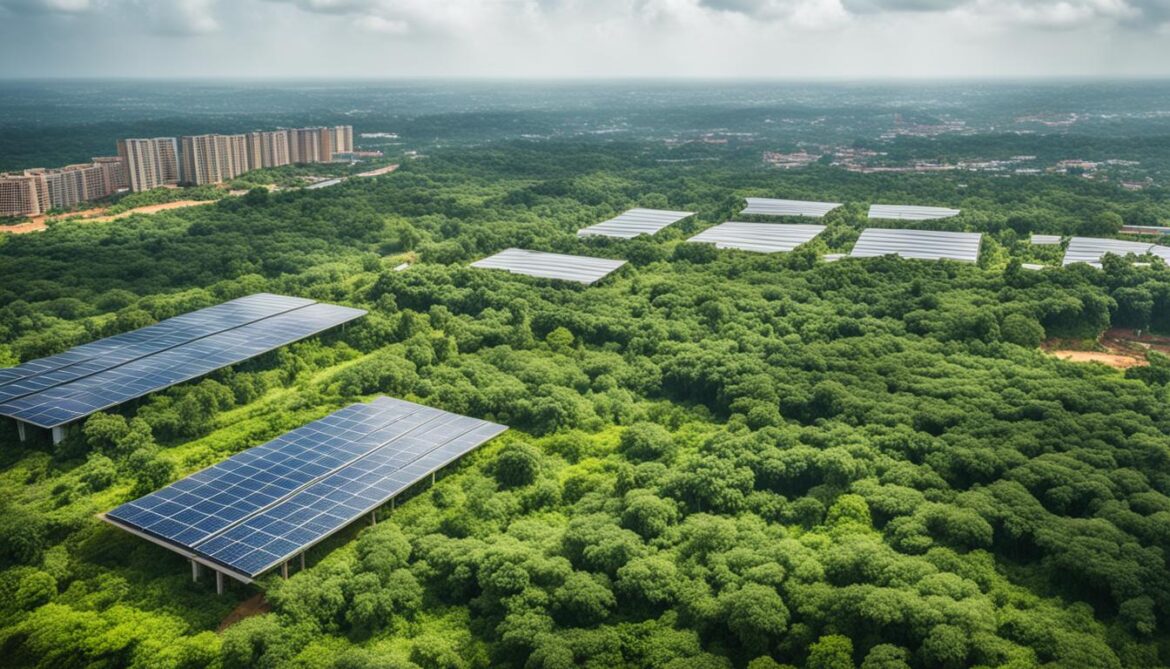
The Benefits of Green Buildings in Ghana
Green buildings in Ghana offer numerous benefits for both occupants and the environment. Some of the key advantages include:
- Improved indoor air quality through the use of natural ventilation systems and low-emission materials.
- Enhanced thermal comfort, reducing the need for excessive heating or cooling.
- Increased productivity and well-being of occupants due to healthier indoor environments.
- Reduced water consumption through the implementation of water-saving fixtures and rainwater harvesting systems.
- Lower operating costs and utility bills for building owners and tenants.
Furthermore, the construction and operation of green buildings contribute to the development of a green economy in Ghana. This supports job creation, promotes local innovation, and attracts investments in sustainable development.
The Role of Green Building Design in Sustainable Architecture
Green building design is an essential component of sustainable architecture in Ghana. It aligns with the country’s commitment to environmental sustainability and biodiversity conservation. Sustainable architecture aims to minimize the negative impacts of the built environment on the natural world while providing functional and aesthetically pleasing spaces for people.
“Sustainable architecture in Ghana goes beyond creating visually appealing structures. It’s about adopting an integrated design approach that considers the environmental, social, and economic aspects of a project. By incorporating green building design principles, architects can contribute to a more sustainable future for Ghana,” explains Nana Osei, a renowned sustainable architect.
Green building design is not limited to new construction; it can also be applied to retrofitting existing buildings to improve their energy efficiency and sustainability performance. This presents an opportunity to transform Ghana’s existing building stock into more environmentally friendly and resource-efficient structures.
| Green Building Design Strategies | Benefits |
|---|---|
| Passive design techniques | Reduces reliance on mechanical heating and cooling systems, resulting in energy savings. |
| Water-efficient fixtures and systems | Reduces water consumption and lowers utility costs. |
| Renewable energy integration | Reduces reliance on non-renewable energy sources and mitigates greenhouse gas emissions. |
| Waste management and recycling | Minimizes waste generation and promotes a circular economy. |
Overall, green building design plays a crucial role in Ghana’s sustainable development efforts. It not only contributes to environmental sustainability but also enhances the quality of life for its citizens. By prioritizing sustainable architecture and embracing eco-conscious construction practices, Ghana can pave the way for a greener and more sustainable future.
Financing Green Buildings in Ghana
While specific green building finance products are not yet available in Ghana, initiatives such as energy efficiency loans are being explored to support the financing of green buildings. These loans incentivize developers and property owners to adopt sustainable building practices by providing financial assistance. They aim to promote investment in energy-saving technologies, renewable energy systems, and other environmentally-friendly features.
“Energy efficiency loans provide a valuable opportunity for developers and property owners in Ghana to embrace sustainable building practices. By offering financial support, these initiatives encourage the adoption of energy-saving technologies and renewable energy systems, ultimately contributing to environmental sustainability and green infrastructure development,”
International organizations and development agencies are also supporting Ghana’s green building efforts by providing financing options and technical support. These collaborations enable the implementation of sustainable architecture Ghana projects and promote environmental sustainability Ghana. By leveraging these resources, Ghana can accelerate the transition towards a greener future and create a built environment that aligns with global standards of sustainability.
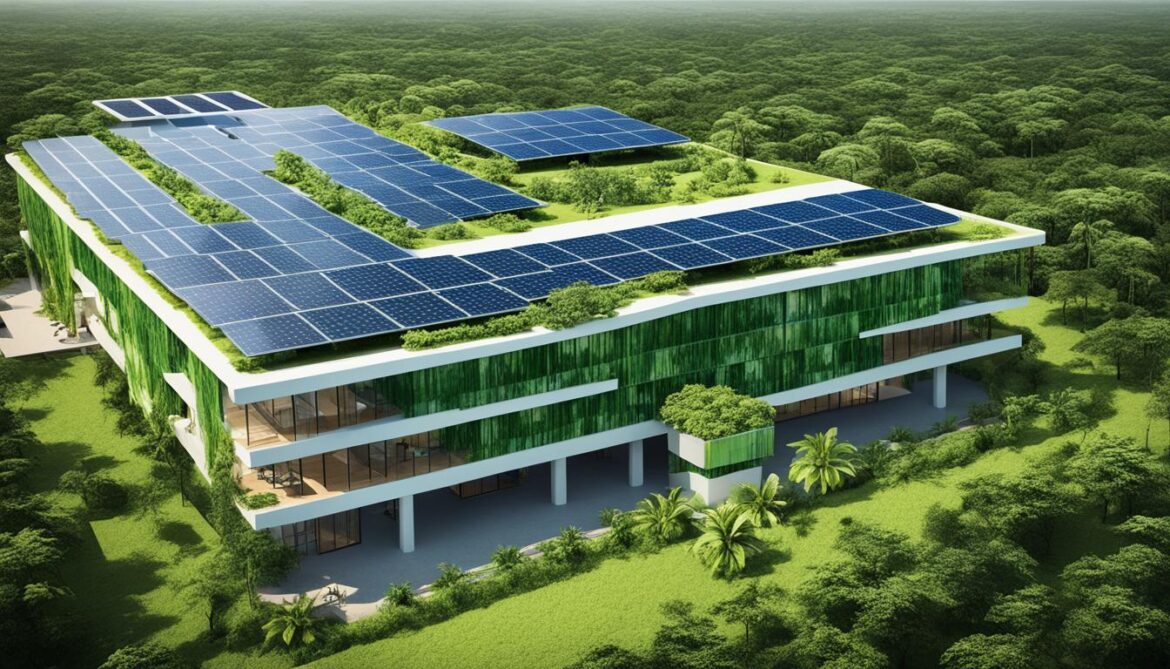
The financing of green buildings in Ghana is a critical aspect of promoting sustainable architecture Ghana and ensuring the long-term environmental sustainability Ghana. As the demand for green infrastructure Ghana continues to grow, it is essential to establish robust financing mechanisms to support the development of eco-conscious buildings and infrastructure projects. By prioritizing financial assistance for sustainable building practices, Ghana can pave the way for a greener and more sustainable future.
The Future of Biodiversity in the Built Environment
The future of biodiversity in the built environment depends on proactive measures to protect and enhance it. Ghana recognizes the importance of preserving biodiversity and is taking steps to ensure that new construction developments have a positive impact on the ecosystem.
One of the proposed measures is mandatory biodiversity net gain, which aims to create more potential habitats for animals and plants to thrive than before the development. This ensures that every new project contributes to the overall biodiversity conservation efforts in Ghana.
Additionally, the UN Biodiversity Conference (COP15) is setting action targets for 2030 to address biodiversity loss. As part of these targets, businesses will be required to assess and report on their impacts on biodiversity. This will create greater accountability and encourage organizations to prioritize biodiversity conservation in their practices.
The built environment plays a significant role in conserving biodiversity, and Ghana is committed to integrating it into urban planning and sustainable architecture. By incorporating green spaces, such as parks and gardens, into urban areas and implementing eco-friendly design principles, Ghana aims to create a sustainable and biodiverse built environment.
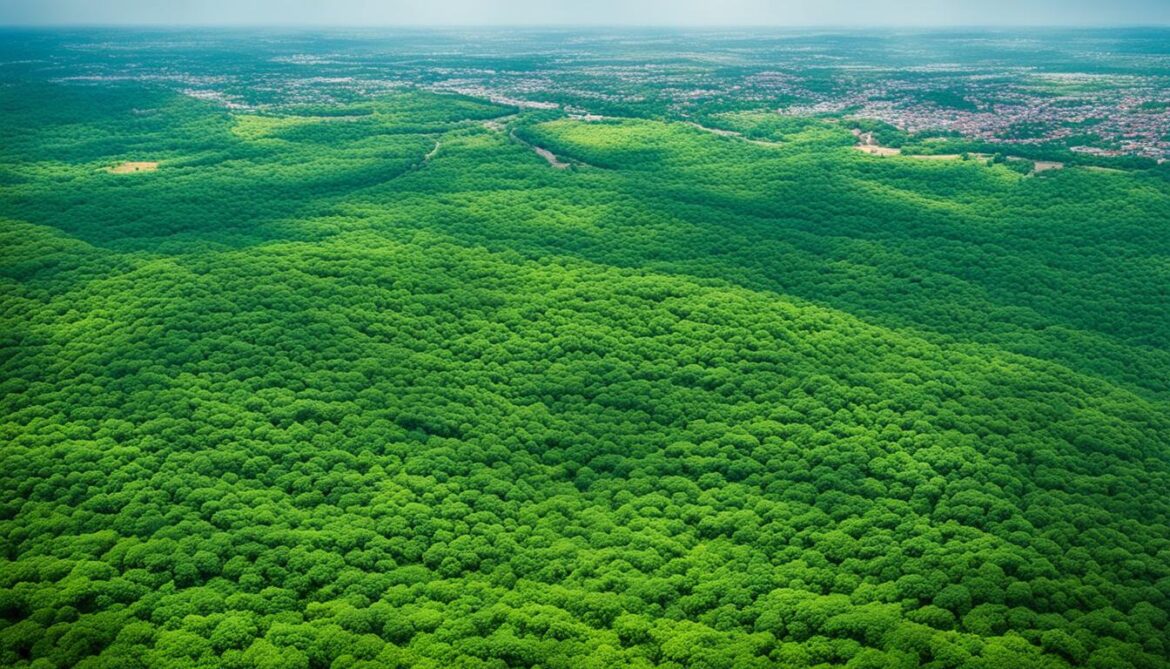
Importance of Biodiversity in the Built Environment
The importance of biodiversity in the built environment cannot be overstated. It provides essential ecosystem services, such as pollination, water purification, and climate regulation. By valuing and protecting biodiversity, Ghana can ensure the long-term sustainability of its built environment and create a healthier environment for its citizens.
To highlight the significance of biodiversity in the built environment, let’s take a look at the following table:
| Benefits of Biodiversity in the Built Environment | Examples |
|---|---|
| Enhanced ecosystem services | Pollination by bees, water filtration by wetlands |
| Improved air quality | Absorption of pollutants by plants |
| Increased resilience to climate change | Carbon sequestration in forests |
| Enhanced well-being and quality of life | Access to green spaces for recreation and relaxation |
| Preservation of local ecosystems | Habitat preservation for native plant and animal species |
Biodiversity conservation should be a top priority in urban planning and sustainable architecture practices to ensure the integration of nature in the built environment. Ghana’s commitment to this objective will pave the way for a greener, more sustainable future.
Conclusion
Ghana’s commitment to integrating biodiversity into the built environment through urban planning and sustainable architecture is a crucial step towards a greener future. By prioritising environmental sustainability, Ghana has the opportunity to strike a balance between economic development and the conservation of biodiversity.
The Annual Ghana Green Building Summit and the proposed regulations for mandatory biodiversity net gain exemplify the country’s dedication to preserving and enhancing its natural resources. Through continuous focus on sustainable practices and promoting awareness of the importance of biodiversity, Ghana is paving the way for a more sustainable built environment and a healthier future.
By actively participating in initiatives like the Annual Ghana Green Building Summit and implementing policies to protect and enhance biodiversity, Ghana demonstrates its commitment to sustainable architecture and biodiversity conservation. With concerted efforts and continued momentum, Ghana can successfully create a built environment that harmonizes with nature and fosters a greener, more sustainable future.








